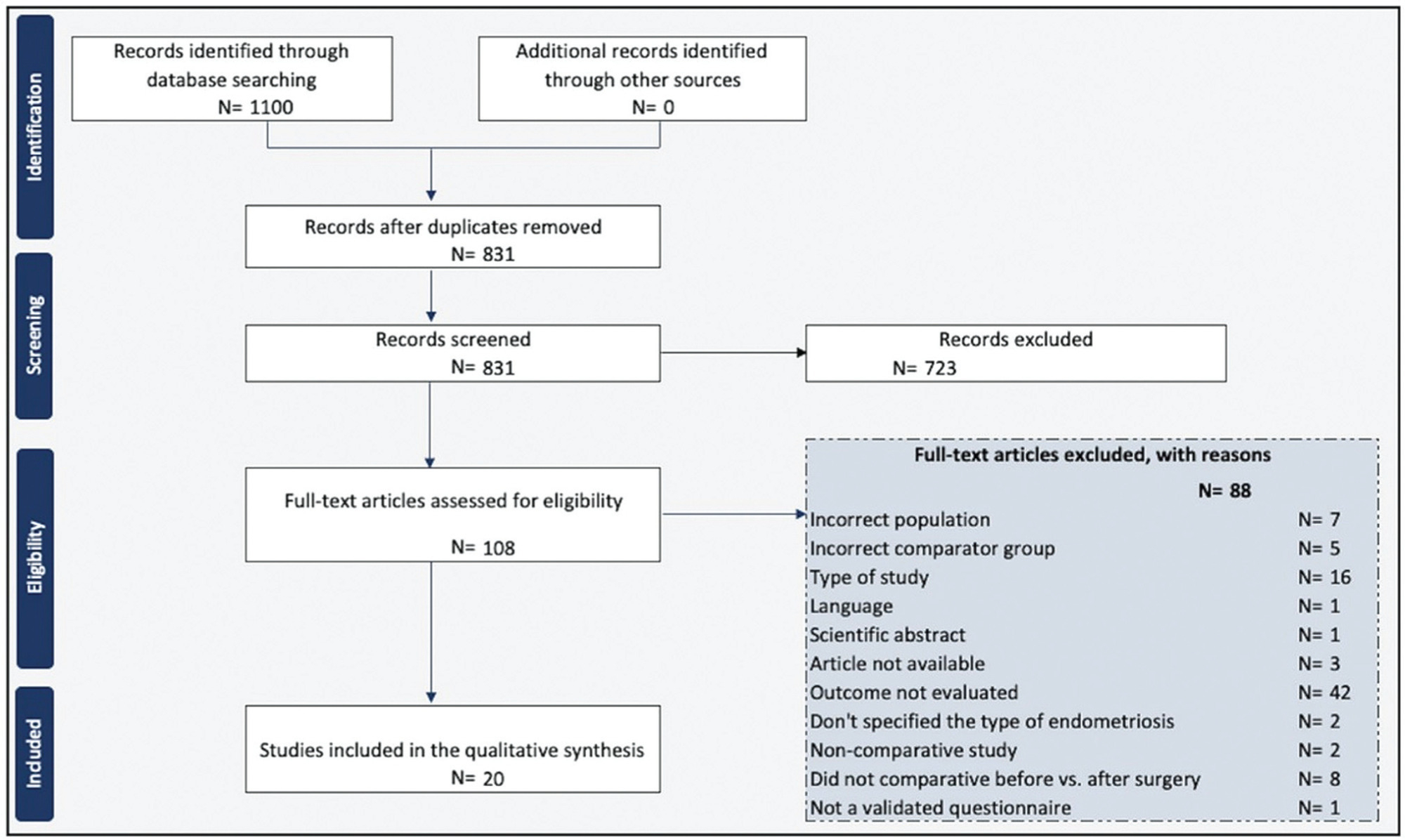-
Review Article
Sexual Function of Patients with Deep Endometriosis after Surgical Treatment: A Systematic Review
Revista Brasileira de Ginecologia e Obstetrícia. 2023;45(11):729-744
12-05-2023
Summary
Review ArticleSexual Function of Patients with Deep Endometriosis after Surgical Treatment: A Systematic Review
Revista Brasileira de Ginecologia e Obstetrícia. 2023;45(11):729-744
12-05-2023Views198See moreAbstract
Objective
To review the current state of knowledge on the impact of the surgical treatment on the sexual function and dyspareunia of deep endometriosis patients.
Data Source
A systematic review was conducted in accordance with the Meta-Analysis of Observational Studies in Epidemiology (MOOSE) guidelines. We conducted systematic searches in the PubMed, EMBASE, LILACS, and Web of Science databases from inception until December 2022. The eligibility criteria were studies including: preoperative and postoperative comparative analyses; patients with a diagnosis of deep endometriosis; and questionnaires to measure sexual quality of life.
Study Selection
Two reviewers screened and reviewed 1,100 full-text articles to analyze sexual function after the surgical treatment for deep endometriosis. The risk of bias was assessed using the Newcastle-Ottawa scale for observational studies and the Cochrane Collaboration's tool for randomized controlled trials. The present study was registered at the International Prospective Register of Systematic Reviews (PROSPERO; registration CRD42021289742).
Data Collection
General variables about the studies, the surgical technique, complementary treatments, and questionnaires were inserted in an Microsoft Excel 2010 (Microsoft Corp., Redmond, WA, United States) spreadsheet.
Synthesis of Data
We included 20 studies in which the videolaparoscopy technique was used for the excision of deep infiltrating endometriosis. A meta-analysis could not be performed due to the substantial heterogeneity among the studies. Classes III and IV of the revised American Fertility Society classification were predominant and multiple surgical techniques for the treatment of endometriosis were performed. Standardized and validated questionnaires were applied to evaluate sexual function.
Conclusion
Laparoscopic surgery is a complex procedure that involves multiple organs, and it has been proved to be effective in improving sexual function and dyspareunia in women with deep infiltrating endometriosis.

-
Original Articles
Sexual dysfunction in obese women is more affected by psychological domains than that of non-obese
Revista Brasileira de Ginecologia e Obstetrícia. 2015;37(12):552-558
12-01-2015
Summary
Original ArticlesSexual dysfunction in obese women is more affected by psychological domains than that of non-obese
Revista Brasileira de Ginecologia e Obstetrícia. 2015;37(12):552-558
12-01-2015DOI 10.1590/SO100-720320155443
Views64See moreAbstract
PURPOSE:
To compare differences in the occurrence and changed domains of sexual dysfunction in obese and non-obese Brazilian women.
METHODS:
Female Sexual Function Index, based on six domains, to investigate 31 sexual dysfunction incidence for obese compared to 32 non-obese women, was used. Statistical analysis using ANOVA and MANOVA were performed to compare total scores of Female Sexual Function Index among groups and to identify the differences among domains, Student t -test was used. Statistical significant level was established for all tests for p<0.05.
RESULTS:
No difference in female sexual dysfunction frequency between obese (25.8%) and non-obese women (22.5%) was found. However, an important distinction in which aspects of sexual life were affected was found. While the obese group was impaired in three domains of sexual life (desire, orgasm, and arousal), in the control group five aspects were dysfunctional (desire, orgasm, arousal, pain and lubrication). Future research exploring psychological outcomes in obese females, such as body image and measures of positive and negative effect, might better characterize the female sexual dysfunction in this group.
CONCLUSIONS:
Obesity does not appear to be an independent factor for allow quality of female sexual life. However, disturbance associated to obesity indicates a low frequency of disorder in physical domains, suggesting that psychological factors seem to be mainly involved in the sexual dysfunction in obese women.


